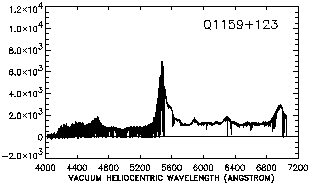


Owing to the non-linear collapse of cosmic structures, the IGM is
well known to be highly inhomogeneous. The discrete gaseous systems detected
in absorption in the spectra of high-redshift quasars blueward of the
Ly emission line are assigned different names based on the appearance of their
absorption features (see Figure 1).
emission line are assigned different names based on the appearance of their
absorption features (see Figure 1).

|
Figure 1. High resolution
( |
The term ``Ly forest'' is used
to denote the plethora of narrow absorption
lines whose measured equivalent widths imply H I column densities ranging from
1016 cm-2 down to 1012
cm-2. These systems, observed to
evolve rapidly with redshift between 2 < z < 4, have
traditionally been interpreted as intergalactic gas clouds associated with
the era of baryonic
infall and galaxy formation, photoionized (to less than a
neutral atom in 104) and photoheated (to temperatures close
to 20,000 K)
by a ultraviolet background close to the one inferred from the integrated
contribution from quasars. Recent spectra at high resolution and
high signal-to-noise obtained with the Keck telescope have shown that
most Ly
forest'' is used
to denote the plethora of narrow absorption
lines whose measured equivalent widths imply H I column densities ranging from
1016 cm-2 down to 1012
cm-2. These systems, observed to
evolve rapidly with redshift between 2 < z < 4, have
traditionally been interpreted as intergalactic gas clouds associated with
the era of baryonic
infall and galaxy formation, photoionized (to less than a
neutral atom in 104) and photoheated (to temperatures close
to 20,000 K)
by a ultraviolet background close to the one inferred from the integrated
contribution from quasars. Recent spectra at high resolution and
high signal-to-noise obtained with the Keck telescope have shown that
most Ly forest clouds at
z ~ 3 down to the detection limit of the
data have undergone some chemical enrichment, as evidenced by weak, but
measurable C IV lines. The typical inferred metallicities range from
0.3% to 1% of solar values, subject to uncertainties of photoionization
models. Clearly, these metals were produced in stars that formed in a denser
environmemt; the metal-enriched gas was then expelled from the regions of star
formation into the IGM.
forest clouds at
z ~ 3 down to the detection limit of the
data have undergone some chemical enrichment, as evidenced by weak, but
measurable C IV lines. The typical inferred metallicities range from
0.3% to 1% of solar values, subject to uncertainties of photoionization
models. Clearly, these metals were produced in stars that formed in a denser
environmemt; the metal-enriched gas was then expelled from the regions of star
formation into the IGM.
An intervening absorber at redshift z having a neutral hydrogen column
density exceeding 2 x 1017 cm-2 is optically thick to
photons having energy greater than 13.6 eV, and produces a discontinuity at
the hydrogen Lyman limit,
i.e. at an observed wavelength of 912 (1 + z)Å. These
scarcer ``Lyman-limit
systems'' (LLS) are associated with the extended gaseous haloes of bright
galaxies near the line-of-sight, and have metallicities which appear to be
similar to that of Ly forest clouds.
forest clouds.
In ``damped Ly systems' the H I
column is so large (NHI
systems' the H I
column is so large (NHI
 1020
cm-2, comparable to the
interstellar surface density of spiral galaxies today) that the radiation
damping wings of the Ly
1020
cm-2, comparable to the
interstellar surface density of spiral galaxies today) that the radiation
damping wings of the Ly line
profile become detectable. While relatively rare, damped systems account for
most of the neutral hydrogen seen at high redshifts. The typical metallicities
are about 10% of solar, and do not evolve significantly over a redshift
interval 0.5 < z < 4 during which most of today's stars were
actually formed.
line
profile become detectable. While relatively rare, damped systems account for
most of the neutral hydrogen seen at high redshifts. The typical metallicities
are about 10% of solar, and do not evolve significantly over a redshift
interval 0.5 < z < 4 during which most of today's stars were
actually formed.
Except at the highest column densities, discrete absorbers are inferred to be strongly photoionized. From quasar absorption studies we also know that neutral hydrogen accounts for only a small fraction, ~ 10%, of the nucleosynthetic baryons at early epochs.